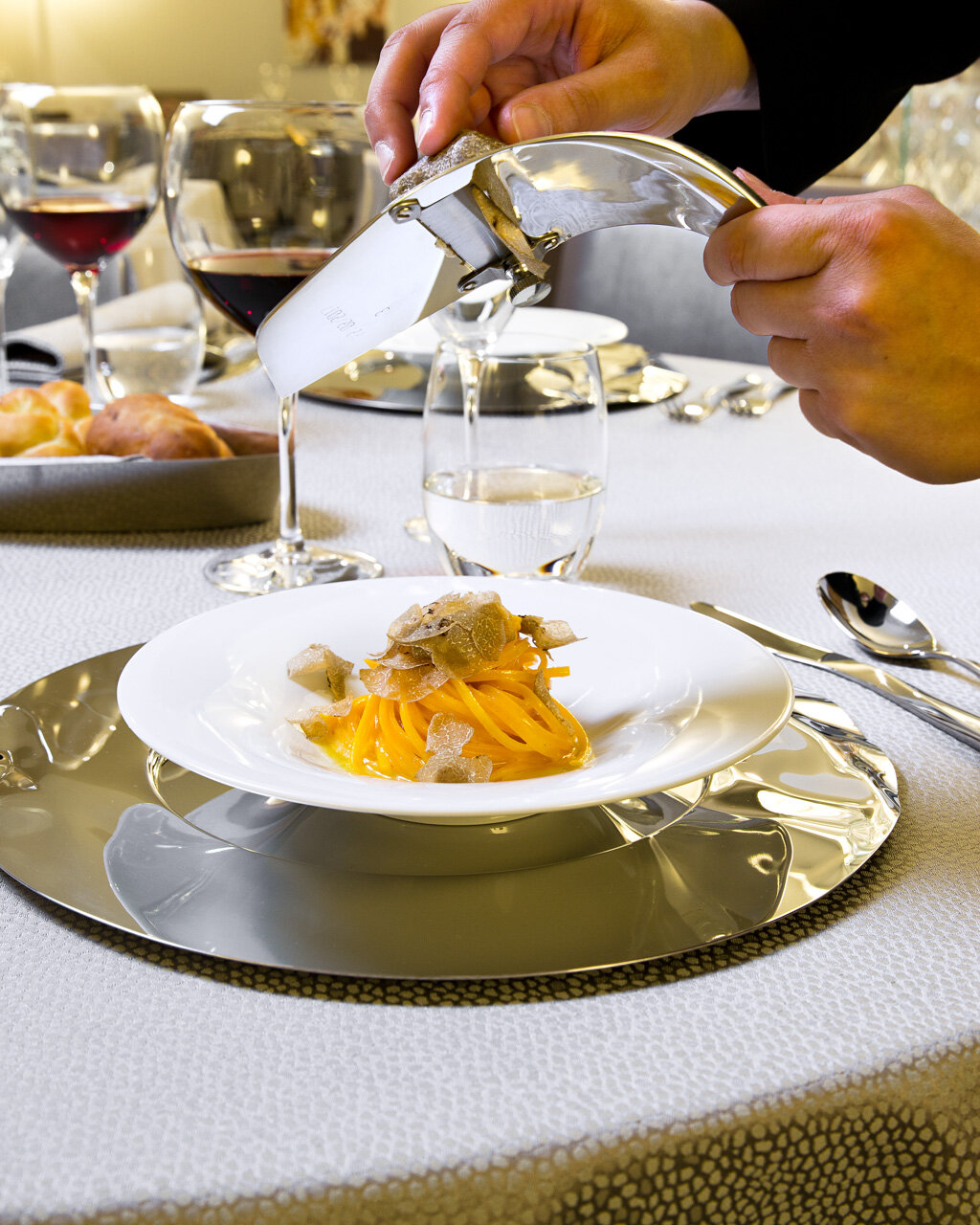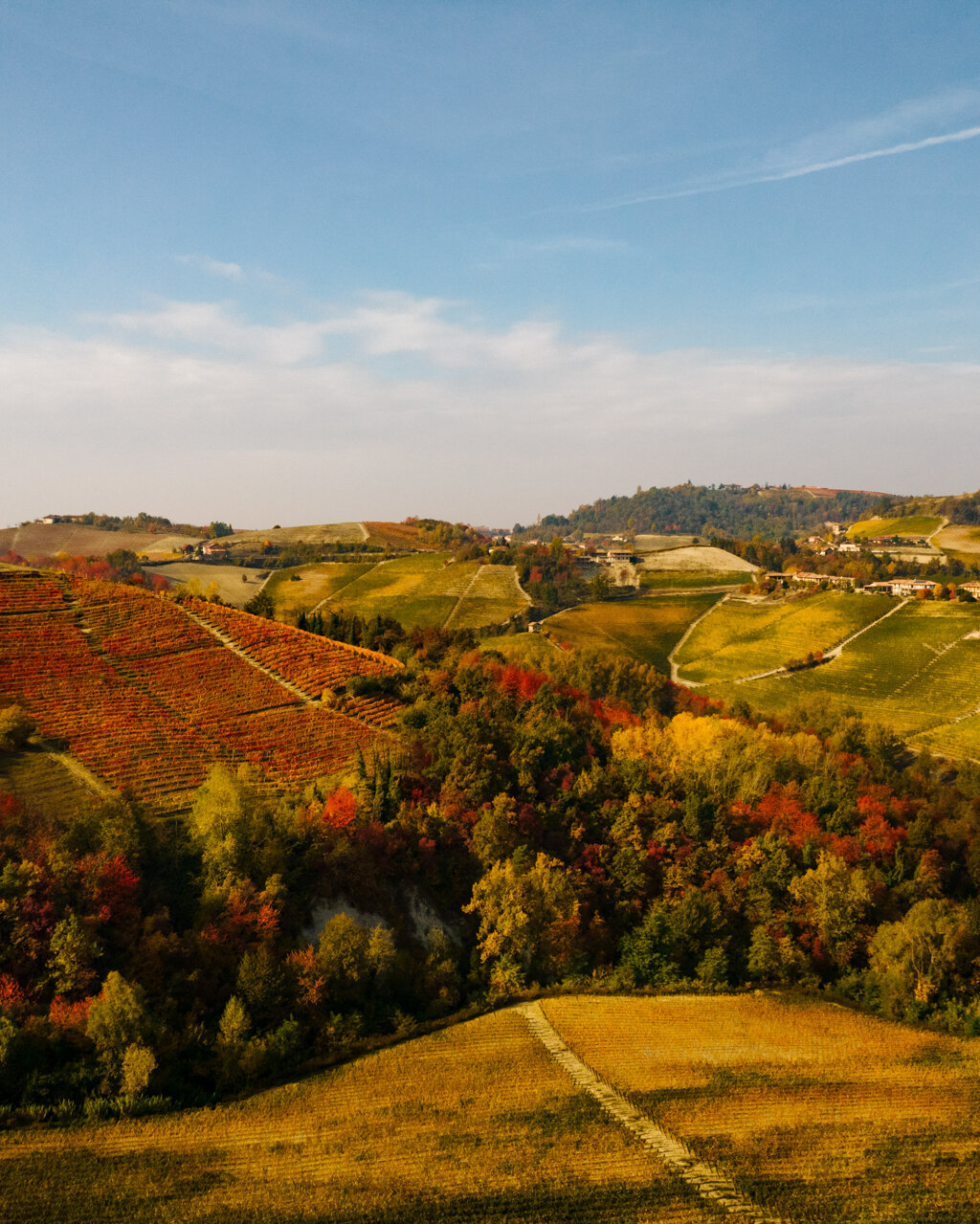From here, continue to the left briefly and then start climbing again. At the fork, continue up to the right along a gravel road, following the signs for Vesime. Cross a lovely chestnut grove and continue along a false flat, then descend to an intersection near Cascina Imperatore. Continue along the crest of the hill and head up a difficult dirt road for a brief section until you find a stone wall. Continue to the left up to the summit of the hillcrest, after which this panoramic trail heads into a forest of oak and pine trees as it descends again to a saddle in the hill and a paved road (Strada Cadacanelli). The watershed here between the Belbo and Bormida rivers is especially open and stunning. Further on, when the crest takes you to the Gaminella hill, the geography turns to gorges, ravines and woods, complicating the simpler watershed you have been following thus far.
Take a moment to enjoy the view out across the wildest parts of the Langhe, where isolated houses are rare and villages wind around the hilltops, closed within stone walls and forbidding fortalices. All around you are fragrant woods full of chestnut, linden, acacia and elm trees, with willows along the valleys and oaks on the hilltops, which, as legend has it, await the thunderbolts from the gods that are what make the magical white truffles here.
Head up along this final section until the next saddle in the hill (sign indicating Strada Ghirardi), where you will take the central road along a false flat. When you have passed an abandoned rest area and a section of cultivated fields, continue on for about 300 metres (at a sign indicating Strada Madovito), then take the paved road up to the right, which will take you quickly to the crest of the hill. Continue through the cultivated fields to an area near hillside vineyards and the Langa Soprana farmhouse. At the first crossroads, head down to the right. After about 100 metres, keep to the left and follow the signs for Santo Stefano Belbo. This section, which features a stunning view of the Bormida Valley to the right, will take you to an intersection on the hillcrest. Take the central, dirt road through old-growth downy oak trees to an ample amphitheatre of vineyards above Cascina Borgna overlooking the Bormida Valley. Ignore the first two roads to the left and head into the woods, where you will soon start to ascend through these woods and a vineyard. A well-groomed section of road will take you gradually upward to a small clearing at the top of the hill.
You will need to take the trail that heads down to the left and follow it to an ample saddle in the hill and a paved road. Follow the paved road to the left briefly and enjoy the panorama. The road heads slightly uphill towards the cell tower atop Bric Bertrani. Just before the fence, head down to the left along a dirt road until you reach a saddle in the hill and Cascina Cà Nuova, where there is a monument commemorating a group of resistance fighters who were executed in Falchetto. This place is of particular importance to locals, who gather here every April 25th, Liberation Day in Italy, to remember the event. Following the signage for Rocchea, take the flat road to the right, which runs through woods and down steep vineyards into the valley of Rocchea and on to the hamlet of Monti. Just past the houses, the road bends to the left. Follow the signs for Torre until a crossroads (sign for Casotto) and continue along the hillside road in the direction of the Church of Santa Libera. Pass the hamlet and continue on to the next intersection.
Santa Libera was impacted by a severe crisis in 1946, which nearly pushed the hamlet into civil war. A group of resistance fighters from Asti, dissatisfied with the politics of 1945 and, above all, with the amnesty called for by Togliatti in 1946, decided to take up arms again and head back into the Langhe to protest. With Prime Minister De Gasperi in Paris for the peace treaty and half of Italy occupied by British and American troops, the risk of matters getting out of control was high. Thanks to the efforts of Deputy Prime Minister Pietro Nenni and of numerous leaders of the resistance fighters, a peaceful resolution was reached when troops had already been deployed and a thousand fires of revolt had been (re)lit in the Alps and Apennines. After eight days, without a shot being fired, the resistance fighters returned to Asti (to a heroes’ welcome) and World War II could finally and truly be considered over.
From Santa Libera, head down to Santo Stefano Belbo, which can be seen in the distance, along the steep road to the right. Past the impressive remains of the medieval tower, now damaged to the extent that it almost appears to defy gravity, continue through a few switchbacks to the centre of town. Head down Via Marconi to the lively Piazza Umberto I immediately on the left. Continue on in the welcome shade of the old houses until Centro Studi Cesare Pavese and the lovely Church of SS. Giacomo and Cristoforo in a square that is often the stage for plays dedicated to this Italian author. Continue along the road to Canelli to the home in which Pavese was born. If you then go into the square, you will find an amazing view of the Moncucco hillside with its dry-stone walls and vineyards. The cemetery is not far from here and is now (since 2002) home to the remains of Cesare Pavese, one of Italy’s greatest authors and poets, who died in 1950.
PLEASE NOTE: Responsibility for the maintenance and practicability of the various trails lies with the municipalities where the routes are located. The Tourist Board, therefore, cannot be held responsible for any inefficiencies, but is willingly available to collect your reports so that they can be forwarded to the authorities concerned.


